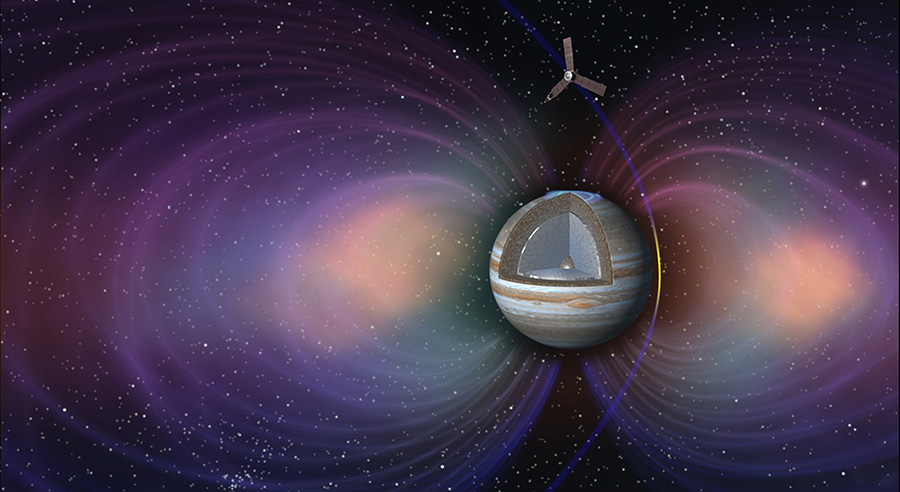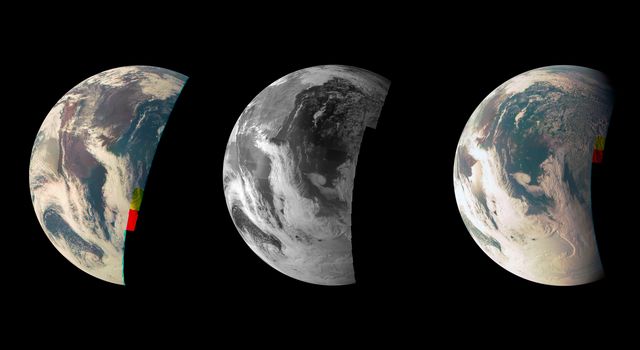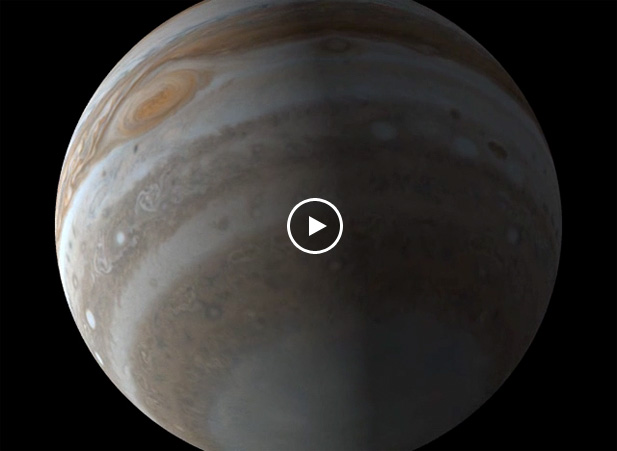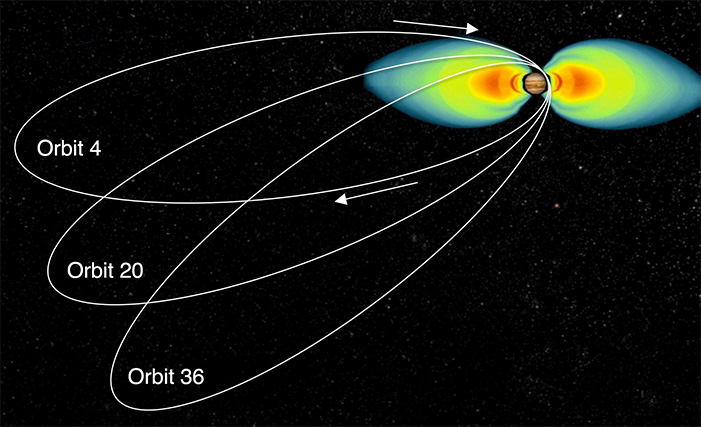Mission Overview
Click for more information
The Juno spacecraft launched aboard an Atlas V551 rocket from Cape Canaveral, Florida, on August 5, 2011. It will go into orbit around Jupiter on July 4, 2016.
As of June 16, 2016, the Juno team has executed two deep space maneuvers (using Juno's main engine) and seven trajectory correction maneuvers (which utilized the spacecraft's attitude control system to provide its propulsive thrust). These planned burns refined the spacecraft's trajectory towards Jupiter. An Earth flyby 26 months after launch provided a boost of spacecraft velocity, placing it on a trajectory for Jupiter.

To accomplish its science objectives, Juno will orbit over Jupiter’s poles and pass very close to the planet. Juno needs to get extremely close to Jupiter to make the very precise measurements the mission is after. This orbital path carries the spacecraft repeatedly through hazardous radiation belts, while avoiding the most powerful (and hazardous) radiation belts. Jupiter’s radiation belts are analogous to Earth’s Van Allen belts -- but far more deadly.
The spacecraft will orbit Jupiter 37 times, with de-orbit into Jupiter at the end of the last orbit. During the almost one-and-a-half-year science phase of the mission, the spacecraft will execute a close flyby above the planet’s cloud tops every 14 days.
Thirteen mission phases have been defined to describe the different periods of activity during Juno’s travels. These phases are: Pre-Launch, Launch, Inner Cruise 1, Inner Cruise 2, Inner Cruise 3, Outer Cruise, Jupiter Approach, Jupiter Orbit Insertion, Capture Orbit, Period Reduction Maneuver, Orbit 2-3, Science Orbits and Deorbit.
Phase 1 - Pre-Launch
The Pre-Launch mission phase lasts from spacecraft power-up at Launch-minus (L-) 3 days to final spacecraft configuration at L-45 minutes.
Phase 2 – Launch
The Atlas V rocket carrying the Juno spacecraft lifted off from Cape Canaveral Air Force Station in Florida on August 5, 2011 at 9:25 a.m. PDT (12:25 p.m. EDT). The Atlas V551 is a two- stage launch vehicle that uses a standard Atlas booster with five solid rocket boosters in the first stage and a Centaur upper stage for the second. The Centaur upper stage had a restartable engine and was three-axis stabilized.
Juno’s trajectory to Jupiter consists of five phases over five years and one-and-a-half loops of the sun. During cruise, the spacecraft is usually oriented so that its high-gain antenna is Earth-pointed. However, close to the sun there are times where thermal and power requirements did not allow for Earth-pointing of the antenna. At those times, the spacecraft was pointed off-sun in such a way that thermal requirements could be met.
Inner Cruise Phase 1
Transition from the Launch Phase to the Cruise Mission Phase occurred three days after launch. The Inner Cruise 1 phase spanned the interval from L+3 to L+66 days. It was characterized by initial spacecraft and instrument checkouts, deployment of the Waves instrument antenna and Juno’s first trajectory correction maneuver.
Inner Cruise Phase 2
The Inner Cruise 2 phase spanned the period from L+66 days until L+663 days (1.6 years in length). The mission’s two deep space maneuvers occurred during this phase, prior to the spacecraft’s one Earth flyby. The dates for the deep space maneuvers were Aug. 30, 2012, and Sept. 14, 2012. The Deep Space Maneuvers were planned and conducted to minimize the number of first-time events at Jupiter Orbit Insertion. The Deep Space Maneuvers featured the use of the main engine, telemetry downlink (tones) from spacecraft to Earth via toroidal antenna, simultaneous coverage of the burns by two 70-meter antennas of NASA's Deep Space Network, and burns lasting approximately 30 minutes.
Other spacecraft activities during the Inner Cruise 2 phase included calibrations and alignments associated with using the high-gain antenna for the first time. The spacecraft’s science instruments were also checked out again.
Inner Cruise Phase 3
The Inner Cruise 3 phase spans the interval from L+663 days to L+823 days. During this time, the Juno flight team focused on performing the required maneuvers, as well as an integrated operations exercise around Earth flyby.

Views of Earth from JunoCam during the Earth flyby gravity assist maneuver in Oct. 2013. Credit: NASA/JPL-Caltech/MSSS
The Earth flyby occurred as the spacecraft was completing its first elliptical orbit around the sun. It boosted Juno’s velocity by 16,330 mph (about 7.3 kilometers per second), placing the spacecraft on its final trajectory for Jupiter. Closest approach to Earth occurred on Oct. 9, 2013, at an altitude of 310 miles (500 kilometers).
During the flyby, Juno passed behind Earth as seen from the sun, causing an interval when Earth blocked the sun’s rays from reaching the spacecraft’s solar panels. The time in eclipse was about 19 minutes and represented the only time after Launch Phase when Juno did not receive direct sunlight. Six of Juno's eight instruments collected data during Earth flyby.
Outer Cruise Phase
The Outer Cruise phase took place between L+822 days until the start of Jupiter Approach at six months to Jupiter Orbit Insertion. During the Outer Cruise phase, which lasted for 26 months, the spacecraft steadily increased its distance from the sun. A few months after Earth Flyby, the spacecraft passed the orbit of Mars, then crossed the main asteroid belt, and then started to approach Jupiter's orbit.
The Jupiter Approach phase lasts the final 6 months of cruise before Jupiter Orbit Insertion and is an opportunity for final checkouts of the spacecraft's flight systems and instruments, as well as the commencement of some limited science observations of the planet. At the beginning of this phase, the project increased its staffing in preparation for Jupiter Orbit Insertion and more than a year of science orbits. The Approach Phase ends four days prior to Jupiter Orbit Insertion (June 30), which is the start of the critical sequence that will result in the spacecraft orbiting Jupiter.
Spacecraft activities during the Jupiter Approach phase include spacecraft subsystem calibrations and maintenance activities, as well as flight software updates and hardware checks in preparation for Jupiter Orbit Insertion. There was also an emphasis on satisfying navigation requirements for trajectory correction maneuvers on the way to Jupiter Orbit Insertion, as well as preparing the Flight System for orbit insertion shortly after the end of this phase.
Calibrations and science observations performed during this phase will help validate instrument performance in the Jupiter environment, testing the data processing pipeline, and preparing the Juno team for successfully returning Jupiter science data once it begins its science mission in Orbit 3.
The Jupiter Orbit Insertion Phase encompasses the critical sequence of activities that will result in Juno obtaining orbit around Jupiter.

The Jupiter Orbit Insertion Phase begins 4 days before the start of the orbit insertion maneuver and ends about 2.5 hours after the start of the insertion maneuver. The burn (insertion maneuver) occurs at the spacecraft’s closest approach to Jupiter, and slows it enough to be captured by the giant planet’s gravity into a 53.5-day orbit. The spacecraft saves fuel by executing a burn that places Juno in a capture orbit with a 53.5-day orbit instead of going directly for the 14-day orbit that will occur during the mission's primary science collection period. Deep Space Network coverage is continuous during this phase.
Jupiter Orbit Insertion is a critical event and is performed as part of a critical sequence. If the Jupiter Orbit Insertion burn fails to insert the spacecraft into orbit around Jupiter, there will be no science mission. To increase the probability that the burn will take place as planned, certain features of the onboard computer's fault protection will be disabled. This decreases the probability that a computer restart or other anomaly could occur during the sequence, interrupting the critical main engine burn. In the event of such an interruption, the sequence is designed such that the spacecraft will quickly reboot and re-start the sequence in order to continue with a successful Jupiter Orbit Insertion burn.

Juno fires its main engine durin orbit insertion.Credit: NASA/JPL-Caltech
Jupiter Orbit Insertion is performed on the main engine (the third large main engine burn of the mission). Thirty-five minutes in length, the burn will impart a mean change in velocity of 1,212 mph (542 meters a second) on the spacecraft. The burn is performed in view of Earth, allowing its progress to be monitored by the mission teams at NASA JPL and Lockheed Martin Space Systems via signal reception by 70-meter Deep Space Network antennas in Goldstone, California, and Canberra, Australia (arrayed with 34-meter antennas in the same locations). The total time off sun-point (where Juno's solar panels are pointed directly into sun) is 103 minutes.
No science observations are planned during the Jupiter Orbit Insertion burn due to the criticality of the event (all instruments are off). All science instruments will be off from about Jupiter Orbit Insertion minus 5 days to Jupiter Orbit Insertion plus 50 hours.
The Capture Orbit phase starts at Jupiter Orbit Insertion plus 2.5 hours and ends October 14 -- five days before the Period Reduction Maneuver, which will place Juno in its 14-day science orbit around Jupiter. All science instruments are expected to be turned on at some point in the Capture Orbit Phase. Calibrations and science observations performed during this phase will help validate instrument performance in the Jupiter environment, test the data processing pipeline, and prepare the Juno team to successfully acquire Jupiter science data during the first planned science orbit -- Orbit 3.
Using the spacecraft’s attitude control system, the mission will execute a short "cleanup maneuver" during the Capture Orbit Phase. This short rocket burn is designed to refine the spacecraft's trajectory around the planet without affecting its 53.5-day orbital period.
During the Period Reduction Maneuver phase, Juno transitions from an orbit that takes 53.5 days to circumnavigate Jupiter to one that takes only 14 days. The phase starts 5.25 days before the maneuver and concludes 50 hours after the maneuver is complete. At about 22 minutes in length, this is the shortest (and last) burn scheduled for Juno’s main engine.
Three science instruments are scheduled to be on during the Period Reduction Maneuver Phase to explore unique scientific opportunities. The Microwave Radiometer instrument will take advantage of the unique attitude and spin rate that occurs during the Period Reduction Maneuver to scan across Jupiter longitudes at a high rate. Juno’s Advanced Stellar Compass instrument will also exploit a unique opportunity for imaging Jupiter's north polar region and darkened hemisphere at low light levels and high time resolution. Juno’s Flux Gate Magnetometer can take additional science data that will be useful in constructing the global magnetic field map, potentially filling in holes that could occur later in the mission.

This animation simulates Juno's view of Jupiter over one of its science orbits, which take two weeks apiece. (The apparent speed of the video slows during closest approach to Jupiter.) Credit: NASA/JPL-Caltech (video: http://www.jpl.nasa.gov/video/details.php?id=1011)
‘Perijove’ is defined as the point in a spacecraft’s orbit where the spacecraft is closest to Jupiter. An ‘apojove’ is exactly the opposite -- it is the location in a spacecraft’s orbit where the spacecraft is farthest from Jupiter. The Juno mission team begins marking perijoves and apojoves with its first close encounter with the planet on July 4 – ‘Perijove 0.’
Now about counting the mission’s orbits. Juno’s ‘Orbit 0’ starts with its first perijove (again at the moment of closest approach to the planet during Jupiter Orbit Insertion -- July 4). ‘Apojove 0’ occurs on July 27 -- when Juno for the first time reaches its most distant point in its orbit from Jupiter. At the moment Juno reaches this first apojove, Juno is considered to be entering ‘Orbit 1.’ Everything that occurs between Apojove 0 and Apojove 1 is part of Orbit 1. Later, when Juno reaches apojove again, it will begin Orbit 2 -- and so on.
The Orbits 2-3 Phase starts 50 hours after the October 19 scheduled Period Reduction Maneuver burn. This phase ends one day before Perijove 4. The Orbits 2-3 phase includes most of the last half of Orbit 2 and all of Orbit 3. Instrument checkouts and science observations are planned during this phase.
The Science Orbit Phase goes from Orbit 4 to Orbit 36. During the phase, the bulk of the science collection for the mission occurs. Small orbit trim maneuvers (each less than 18 mph, 8 meters per second) are planned about four hours after each perijove pass. These orbit trim maneuvers are required so that Juno will achieve the correct longitudinal track over Jupiter during its next perijove pass. This phase also includes one spare orbit (37).
For many of the instruments to do their job, the spacecraft has to get closer to Jupiter than any previous mission. To avoid the highest levels of radiation in the belts surrounding Jupiter, mission navigators have designed a highly elongated orbit that approaches the gas giant from the north. Flying from north to south, the spacecraft’s point of closest approach above the cloud tops varies with each flyby -- coming as close as about 2,600 miles (4,200 kilometers) and as far out as 4,900 miles (7,900 kilometers). As Juno exits over the south pole, its orbit carries it far beyond even the orbit of the Jovian moon Callisto.
Orbiting Jupiter around the poles carries Juno repeatedly over every latitude. As the planet rotates beneath the spacecraft, the entire surface can be covered by Juno’s suite of instruments. Each orbit of Jupiter is about 50 minutes less than about 14 days long on average (or 13.965 days long). This orbit allows Juno to be viewable at every perijove from NASA’s Deep Space Network antennas at Goldstone. This orbit, along with Jupiter’s rotation period of about 9.925-hours, also allows even coverage of Jupiter by Juno’s instruments over the mission’s 32 science orbits.

The tilt of Juno's orbit relative to Jupiter changes over the course of the mission, sending the spacecraft increasingly deeper into the planet's intense radiation belts. Credit: NASA/JPL-Caltech
Juno’s elliptical orbit around Jupiter has another benefit. It allows the spacecraft’s three massive solar panels to be constantly bathed in sunlight. This is important because the amount of sunlight that reaches Jupiter is only 1/25th that which reaches Earth. To keep the spacecraft’s instruments and operating systems powered requires the solar panels to have an almost constant exposure to the available sunlight.
All of Juno’s science instruments will be on during all 32 science orbits. However, all Juno science orbits are not created equal. Some orbits will find Juno flying past the planet in an orientation that best highlights Juno’s Microwave Radiometer (MWR) instrument. Other orbits have Juno flying past Jupiter in an orientation that favors Juno’s gravity science (GRAV) experiment.
During an MWR orbit, Juno’s Infrared imager/spectrometer (JIRAM) and JunoCam will be collecting their best data of the mission because during those orbits, the spacecraft spin axis is oriented to get the best view of the planet directly below (nadir). The gravity science experiment during MWR orbits will still operate, although only with the X-Band instrument. The Ka-band Translator (KaT) that is part of the gravity experiment is turned off during MWR orbits because it requires the spacecraft to be in an Earth-pointed orientation.
During orbits that highlight gravity experiments (GRAV), Juno is in an Earth-pointed orientation that allows the Ka-Band Translator to downlink data in real-time to Earth. However, this Earth-pointed orientation reduces the quantity of MWR, JIRAM and JunoCam data collection.
The final mission phase is the Deorbit phase, which occurs during the final orbit of the mission. The 5.5-day phase starts several days after the Orbit 37 science pass. It ends with Juno’s impact into Jupiter.
The deorbit maneuver was designed to satisfy NASA’s planetary protection requirements and ensure that Juno does not impact the Jovian moons Europa, Ganymede and Callisto.
By orbit 37, a deorbit burn will be executed, placing the spacecraft on a trajectory that will reset its point of closest approach to the planet to an altitude that is below the cloud tops at 34 degrees North Jupiter latitude on February 20. 2018. Juno is not designed to operate inside an atmosphere and will burn up.